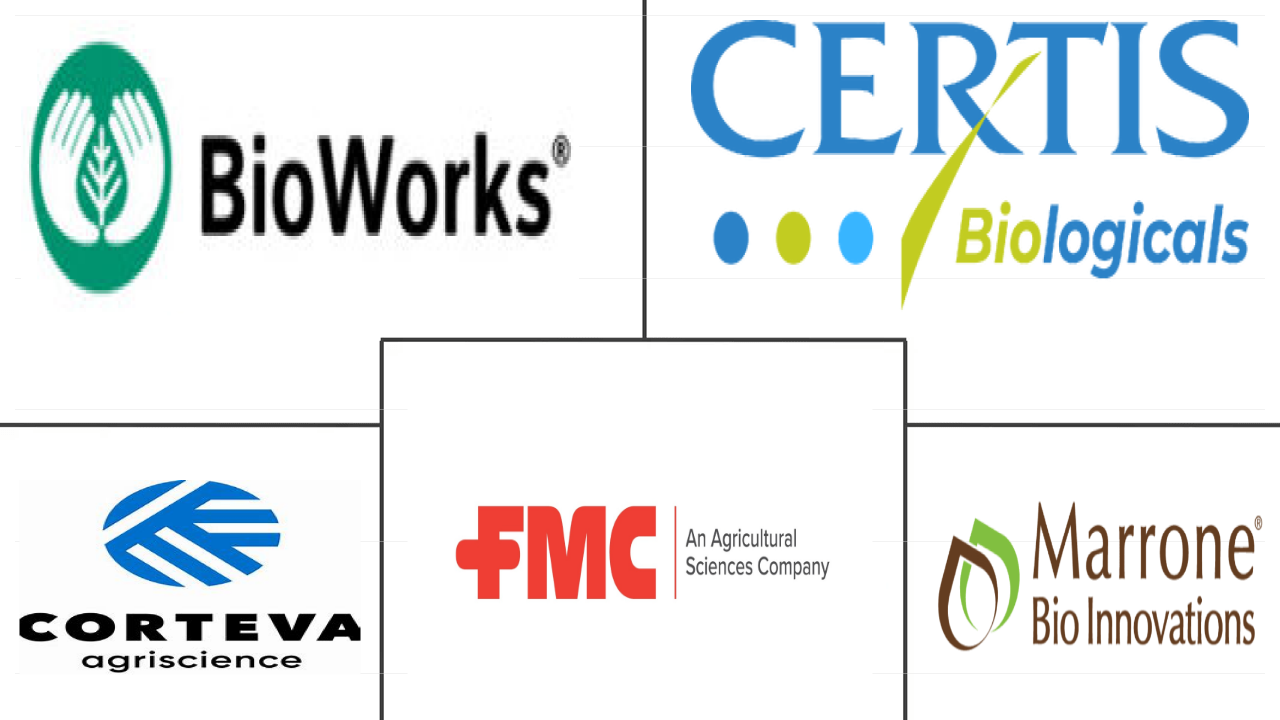Market Size of united states biopesticides Industry
| Icons | Lable | Value |
|---|---|---|
|
|
Study Period | 2017 - 2029 |
|
|
Market Size (2024) | USD 1.66 Billion |
|
|
Market Size (2029) | USD 3.00 Billion |
|
|
Largest Share by Form | Biofungicides |
|
|
CAGR (2024 - 2029) | 12.66 % |
|
|
Fastest Growing by Form | Bioinsecticides |
|
|
Market Concentration | Low |
Major Players |
||

|
||
|
*Disclaimer: Major Players sorted in no particular order |
United States Biopesticides Market Analysis
The United States Biopesticides Market size is estimated at 1.66 billion USD in 2024, and is expected to reach 3.00 billion USD by 2029, growing at a CAGR of 12.66% during the forecast period (2024-2029).
1.66 Billion
Market Size in 2024 (USD)
3.00 Billion
Market Size in 2029 (USD)
11.06 %
CAGR (2017-2023)
12.66 %
CAGR (2024-2029)
Largest by Form
49.09 %
value share, Biofungicides, 2023
Microbial species like Bacillus, Trichoderma, and Pseudomonas, are the most available bio fungicides in the market and are effective in controlling a wide range of diseases.
Fastest by Form
14.54 %
Projected CAGR, Bioinsecticides, 2024-2029
Bacillus Thuringiensis and Beauveria bassiana are the most commercially used bioinsecticides in United States due to their potential in controlling a wide range of pests.
Largest by Crop Type
92.82 %
value share, Row Crops, 2023
The row crops accounted for a maximum share of 92.7% in the consumption of biopesticides in the United States in 2022, with major crops like corn, wheat, rice, soybean, etc.
Fastest by Crop Type
12.78 %
Projected CAGR, Row Crops, 2024-2029
The area under the cultivation of row crops has increased by 21.6% during the historic period (2017-2021) from 3.7 lakh hectares in 2017 to 4.5 lakh hectares in the year 2021
Leading Market Player
2.50 %
market share, Certis USA LLC, 2022

Certis U.S.A LLC's large portfolio of products that meet nearly every need of organic agriculture and has conducted more than 6,000 field trials using biopesticides.
- Biofungicides are substances that are used to control plant diseases caused by pathogenic fungi. Biofungicides may be of microbial or botanical origin. The market for these biofungicides was valued at USD 650.9 million in 2022 and is the most consumed biopesticide type, with a market share of 49.5% in the same year.
- The market for bioinsecticides in the United States was valued at USD 403.9 million in 2022 and accounted for a share of 30.7%, the second most consumed among biopesticides.
- Bioinsecticides are of biological origin, including microorganisms like fungi, bacteria, or even plant extracts that can work against harmful insects that affect the growth and development of crops. On average, these bioinsecticides are applied at the rate of 2.8 kg/hectare in all the crop types. Among bioinsecticides, the bacterial insecticide Bacillus Thuringiensis is the most predominantly used insecticide in agriculture due to its immense potential to control pests by producing proteins during the sporulation phase.
- Bioherbicides are the derivatives of either microbe, plant extracts, or any other phytotoxins used to control the weeds that compete for growth with the crops by suppressing their growth or germinating weed seeds. The market for biological herbicides was valued at USD 108.9 million in 2022, with a volume consumption of 7.5 thousand metric tons in the same year.
- Other biopesticides include products like nematicides, rodenticides, acaricides, and molluscicides, which are of biological origin. These biological pesticides accounted for a share of 11.5% in 2022, occupying the third place after biofungicides and bioinsecticides.
United States Biopesticides Industry Segmentation
Biofungicides, Bioherbicides, Bioinsecticides are covered as segments by Form. Cash Crops, Horticultural Crops, Row Crops are covered as segments by Crop Type.
- Biofungicides are substances that are used to control plant diseases caused by pathogenic fungi. Biofungicides may be of microbial or botanical origin. The market for these biofungicides was valued at USD 650.9 million in 2022 and is the most consumed biopesticide type, with a market share of 49.5% in the same year.
- The market for bioinsecticides in the United States was valued at USD 403.9 million in 2022 and accounted for a share of 30.7%, the second most consumed among biopesticides.
- Bioinsecticides are of biological origin, including microorganisms like fungi, bacteria, or even plant extracts that can work against harmful insects that affect the growth and development of crops. On average, these bioinsecticides are applied at the rate of 2.8 kg/hectare in all the crop types. Among bioinsecticides, the bacterial insecticide Bacillus Thuringiensis is the most predominantly used insecticide in agriculture due to its immense potential to control pests by producing proteins during the sporulation phase.
- Bioherbicides are the derivatives of either microbe, plant extracts, or any other phytotoxins used to control the weeds that compete for growth with the crops by suppressing their growth or germinating weed seeds. The market for biological herbicides was valued at USD 108.9 million in 2022, with a volume consumption of 7.5 thousand metric tons in the same year.
- Other biopesticides include products like nematicides, rodenticides, acaricides, and molluscicides, which are of biological origin. These biological pesticides accounted for a share of 11.5% in 2022, occupying the third place after biofungicides and bioinsecticides.
| Form | |
| Biofungicides | |
| Bioherbicides | |
| Bioinsecticides | |
| Other Biopesticides |
| Crop Type | |
| Cash Crops | |
| Horticultural Crops | |
| Row Crops |
United States Biopesticides Market Size Summary
The United States biopesticides market is experiencing significant growth, driven by the increasing demand for sustainable agricultural practices. Biopesticides, which include biofungicides, bioinsecticides, and bioherbicides, are gaining traction as environmentally friendly alternatives to conventional pesticides. Biofungicides, derived from microbial or botanical sources, are the most widely used, followed by bioinsecticides, which utilize biological organisms to combat pests. The market is characterized by a diverse range of products, including nematicides, rodenticides, acaricides, and molluscicides, all contributing to the market's expansion. The rise in organic farming, supported by favorable regulations and consumer preferences for organic products, is further propelling the demand for biopesticides in the United States.
The market landscape is fragmented, with key players such as Bioworks Inc., Certis USA LLC, Corteva Agriscience, FMC Corporation, and Marrone Bio Innovations Inc. leading the charge. These companies are actively expanding their portfolios through strategic acquisitions and collaborations to enhance their biopesticide offerings. The growing consumer awareness and preference for organic foods, particularly among younger and higher-income demographics, are driving the demand for organic produce, which in turn supports the biopesticides market. As the market continues to evolve, the focus on sustainable and organic farming practices is expected to create new opportunities for growth and innovation in the biopesticides sector.
United States Biopesticides Market Size - Table of Contents
-
1. MARKET SEGMENTATION (includes market size in Value in USD and Volume, Forecasts up to 2029 and analysis of growth prospects)
-
1.1 Form
-
1.1.1 Biofungicides
-
1.1.2 Bioherbicides
-
1.1.3 Bioinsecticides
-
1.1.4 Other Biopesticides
-
-
1.2 Crop Type
-
1.2.1 Cash Crops
-
1.2.2 Horticultural Crops
-
1.2.3 Row Crops
-
-
United States Biopesticides Market Size FAQs
How big is the United States Biopesticides Market?
The United States Biopesticides Market size is expected to reach USD 1.66 billion in 2024 and grow at a CAGR of 12.66% to reach USD 3.00 billion by 2029.
What is the current United States Biopesticides Market size?
In 2024, the United States Biopesticides Market size is expected to reach USD 1.66 billion.

